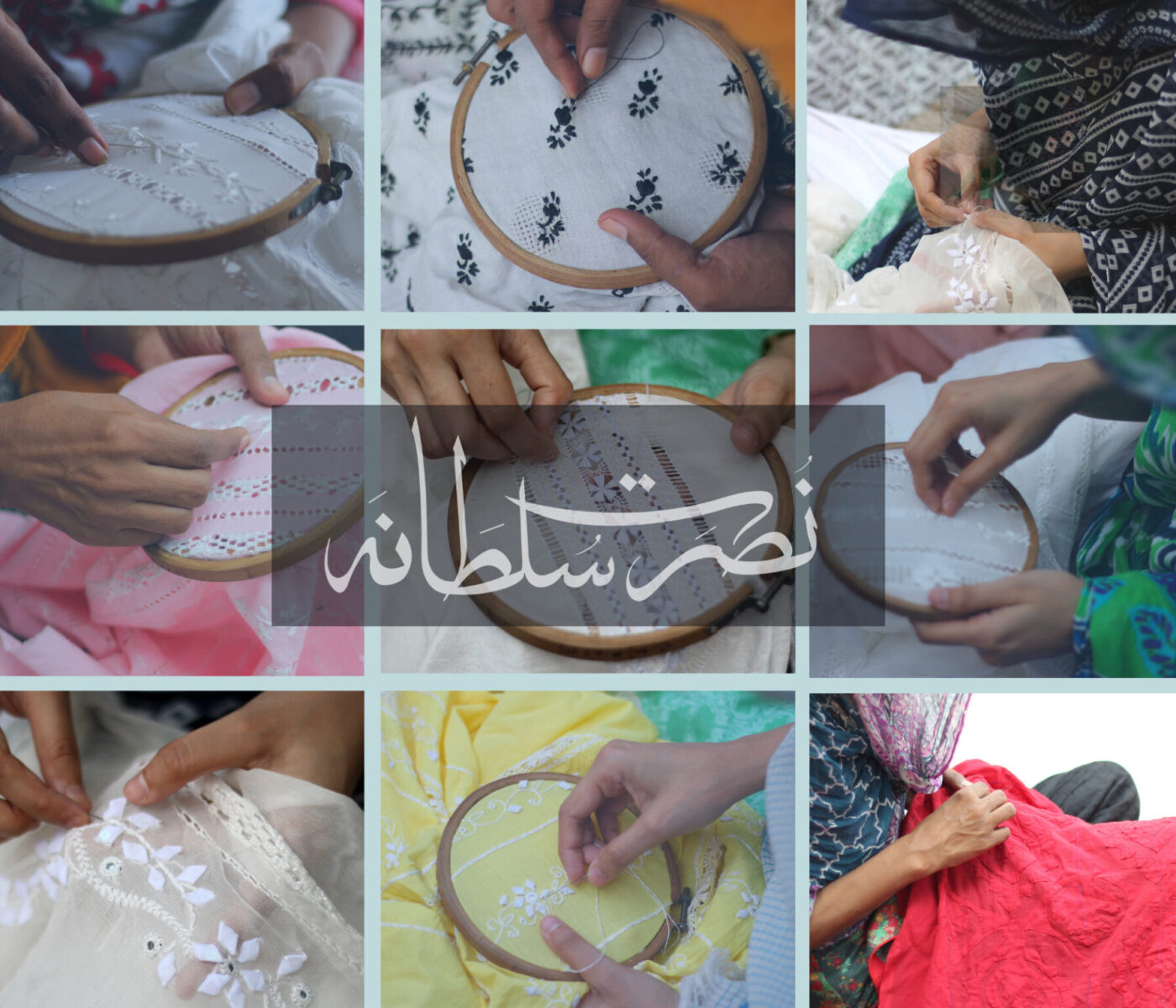Tarkashi Craft
Tarkashi is very interesting but also one of the most complicated handcrafted work. Its patterns and stitches look so royal that this form of embroidery never goes out of the limelight. It is, in fact, largely admired for its beauty and elegance in almost all parts of the world.
The intricacy of Tarkashi work is the outcome of removing horizontal and vertical threads of the fabric in a decorative pattern. The remaining threads are tied, twisted, and secured with decorative stitches. The stitching itself in tarkashi is usually both decorative and functional, as the stitches hold the remaining threads together while adorning the area being worked. The end results give a very lacy look and vary because of the type of fabric and threads used in the process. Its lacy effect gives an extraordinary touch to all western and eastern outfits.
Our tarkashi embellished articles substantially combine traditional and modern designs and patterns to provide you with an outfit you desire. So, if you are looking for a royal outfit with delicate embroidery patterns, browse through our tarkashi collection right now.
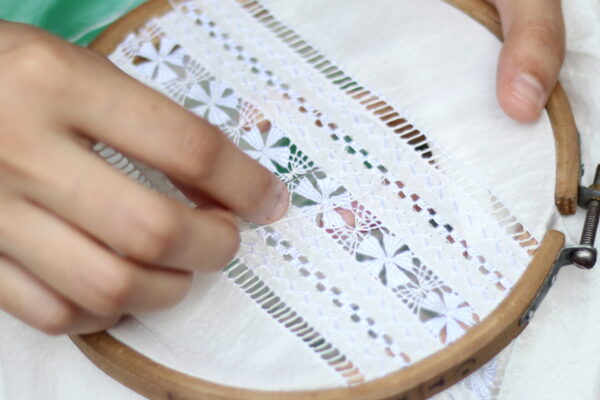
Ralli Work
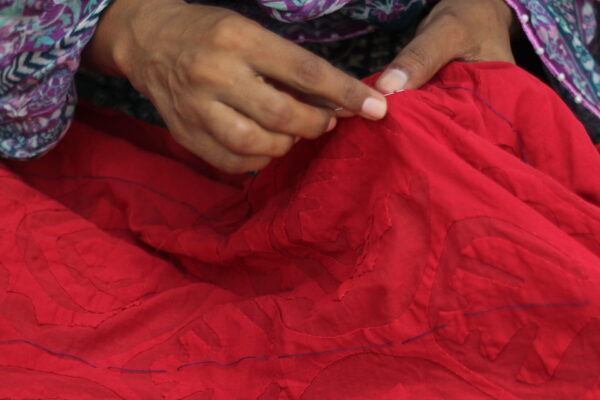
Traditional craft of Ralli is also known as the craft of Indus Valley. The most common technique practiced is patchwork. This craft is mostly crafted by women from remote villages of Sindh (Pakistan). Every ralli artwork has its own story and each ralli illustrates the strength of the traditional old craft. Every ralli narrates the creativity and nature of the crafter.
In the villages of Sindh resides many different tribal communities that practice this craft. Ralli crafts are a visual treat of color, pattern, and energy combined all together in a textile surface. Additionally to the creating of these beautiful intricate seamless designs with colors and shapes. The process behind Ralli is not as simple as it seems to be. It requires time, hard work, and skill. It is an outcome of a billion delicate stitches aesthetically put together by sewing small squares of different fabric pieces in a particular pattern or design.
The stitches crafted are nearly invisible, and the finish of the work speaks volumes. At a glance, the fabric presents a view of an artwork showing a collage of a billion attractive pictures. Undoubtedly, the final result appeals to every eye and is enriched with the essence of culture, tradition, and art.
In other words, ralli crafts enhance the entire outlook of the fabric and are highly demanded of their traditional and cultural significance. The colors and patterns used for crafting ralli embellishments pleasantly complement each other. This aspect identifies why ralli technique is extensively cherished on a variety of textile products.
Chikankari
Chikankari embroidered craft features numerous patterns and designs. One cannot even imagine the amount of time and hard work that goes into crafting a splendid piece of chikankari work. According to a rough estimate, there are around 32 different styles of stitches used in various patterns and embroidered designs of chikankari work. The credit entirely goes to our expert artisans who invest their time and efforts in transforming the entire outlook of an ordinary lawn, cotton, linen, chiffon, or silk fabric.
Initially, chikankari work revolved around embellishing a white fabric with intricate white thread work on it. The decency of the material looked so charismatic that it soon became a symbol of a classy dress sense. Later, the colored fabric served as a canvas for displaying the most delicate embroidery designs and stitches.
However, intricate floral patterns with the most delicate details have constantly mesmerized chikankari lovers for their enchanting appeal. In other words, chikankari work is the epitome of style, finish, and beauty. It truly defines how minimalist stitches and patterns can effortlessly innovate an ordinary fabric into an extraordinary outfit.
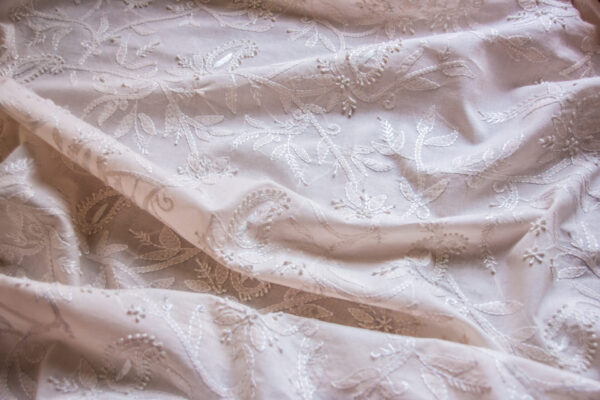
Tukri Work
In tukri work, fabrics are cut into tukri shapes and sizes. These little pieces are then sewn together on a large base fabric to form particular desired patterns or designs. It is commonly used for decoration as patchwork on different fabric to create beautiful textile surfaces. This technique is accomplished by hand embroidery. Tukri work is also an ancient sewing craft, where the designs are achieved by layering small pieces of fabric onto a separate base fabric to form beautiful designs.
Tukri work is more like joining tiny fragments of cloth in a specific design or pattern. The technique behind this form of handwork is a combination of applique/Ralli and collage work. In other words, to create a mind-blowing tukri outfit, different pieces of fabric are assembled in varying shapes and sizes. On the whole, tukri work is considered ideal for enchanting the beauty of all traditional and western outfits.
This form of handwork requires a profound aesthetic sense where using the right pattern and the right color at the right place counts the most in creating an exceptionally beautiful outfit for women. Tukri embellished dresses are admired for their grace and fine detailing. Their unique and intricate stitches tempt women, while their elegance and individuality separate them from the rest.
In Pakistan, the artisans belonging to the interior Sindh areas are experts in crafting this form of handwork. It is their passion and dedication that tukri work is still celebrated for its richness and delicacy.
Mirro Work
Mirror work is the type of hand embroidery that includes attaching small pieces of mirror onto fabric. This craft is also known as sheesha work embroidery in local language. The mirror work are cut to represent shapes such as flower petals and leaves combined with colorful threads and yarns.
Like every fashion, the fashion of mirror work also changes from time to time. In recent times, mirror work is done on plain dresses to add sparkle to dull dresses. Moreover, mirror work also enhances the traditional look of your clothes. The intricate mirror handcrafting becomes the symbol of tradition, decency, and cultural look.
All the mirror work done by the rural female artisans is extraordinary. Mirror work in Pakistan is fused with modern designs, and this mixture gives the dresses both a traditional and chic look.
Shisha work is done with different types and shapes of shishas. Mirrors are attached to the clothes by using modern techniques. The embroidery is done around the mirrors by the rural artisans, and their extraordinary talent is that they don’t use the glue to attach the mirrors, preferably thread techniques are used.
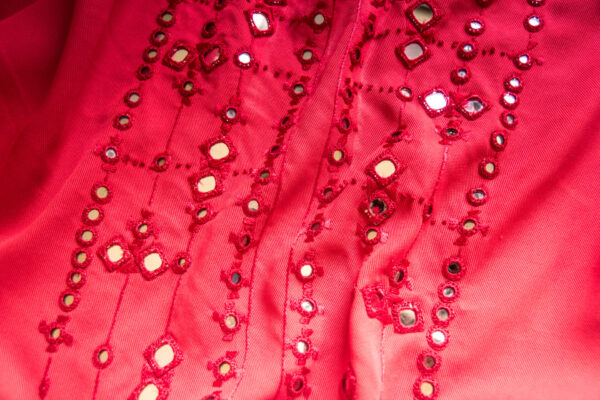
Story Behind Every Craft Matters
Some particular techniques only belong to some specific regions like tarkashi, rally, tukri work, chickenkari, mirror work and exotic types of embroideries. These artisans come forward with their expertise in particular crafts and create wonders with the hand that are impressive beyond words.
